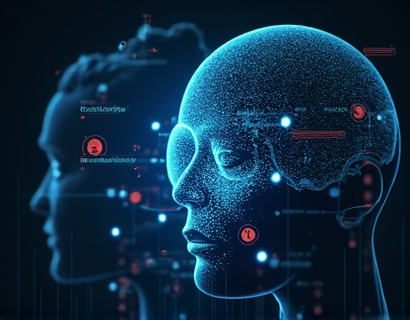Maximizing User Engagement in the Crypto-AI Era: A Guide to Next-Gen Digital Solutions
The intersection of cryptocurrency and artificial intelligence (AI) has given birth to a new paradigm in digital engagement. As technology continues to evolve, the potential for enhanced user experiences and streamlined services in the crypto landscape is immense. This guide delves into the transformative impact of advanced technology on user interaction, offering strategic insights for tech-savvy professionals aiming to thrive in this dynamic ecosystem.
Understanding the Crypto-AI Synergy
The fusion of cryptocurrency and AI represents a powerful synergy that can revolutionize how digital services are delivered and interacted with. Cryptocurrency, with its decentralized and secure nature, provides a robust foundation for building trust and transparency. AI, on the other hand, brings intelligence, adaptability, and efficiency to the table. Together, they create a powerful toolset for enhancing user engagement and experience.
The Transformative Impact on User Experience
The integration of AI in crypto applications can significantly elevate user experience. AI-driven chatbots and virtual assistants can offer 24/7 support, answering queries and guiding users through complex processes with ease. Personalization is another key area where AI shines. By analyzing user behavior and preferences, AI can tailor recommendations and services to individual needs, making the crypto experience more intuitive and user-friendly.
Moreover, AI can enhance security through advanced threat detection and fraud prevention systems. Machine learning algorithms can identify patterns and anomalies in real-time, ensuring that user data remains protected. This not only builds trust but also encourages more users to engage with crypto platforms confidently.
Streamlining Services with AI Technologies
AI technologies can streamline various services within the crypto ecosystem, from trading and investment to wallet management and blockchain development. For instance, AI-powered trading bots can analyze market data and execute trades at optimal times, reducing the emotional bias and increasing the chances of profitable outcomes. These bots can be customized to suit different risk profiles and investment strategies, making advanced trading accessible to a broader audience.
In the realm of wallet management, AI can simplify the process of managing multiple cryptocurrencies. Smart wallets equipped with AI can automatically convert currencies, track transactions, and provide real-time updates on balances and market trends. This level of automation not only saves time but also reduces the potential for human error.
Enhancing Community Engagement
Building a strong community is crucial for the success of any crypto project. AI can play a pivotal role in fostering community engagement by facilitating meaningful interactions and providing valuable insights. Social platforms powered by AI can curate content based on user interests, ensuring that community members are engaged with the most relevant information. This personalized approach can increase participation and loyalty within the community.
AI-driven analytics can also help project leaders understand community sentiment and preferences. By analyzing social media mentions, forum discussions, and other online interactions, AI can provide actionable insights that can inform strategy and improve user satisfaction. This data-driven approach ensures that the community's voice is heard and acted upon, fostering a sense of belonging and trust.
Innovative User Interfaces and Experiences
The next generation of crypto applications will prioritize user interfaces (UIs) and user experiences (UX) that are not only functional but also engaging and intuitive. AI can drive the development of adaptive UIs that adjust to different devices and user contexts. For example, an app could automatically switch to a simplified mode on a mobile device or provide a more detailed view on a desktop screen based on the user's current environment and preferences.
Augmented Reality (AR) and Virtual Reality (VR) integrated with AI can offer immersive experiences that go beyond traditional crypto interfaces. Users can visualize blockchain transactions, explore decentralized applications (dApps), and interact with digital assets in a more tangible and interactive way. This not only enhances engagement but also educates users about the technology, reducing barriers to entry.
Strategies for Implementing AI in Crypto Projects
For developers and project leaders looking to incorporate AI into their crypto initiatives, several strategies can be employed to maximize user engagement and service efficiency.
1. Define Clear Objectives
Before integrating AI, it's essential to define clear objectives. What specific problems do you aim to solve? Whether it's improving user onboarding, enhancing trading algorithms, or personalizing content, having a clear goal will guide the implementation process and ensure that the AI solutions are aligned with user needs.
2. Invest in Quality Data
AI's effectiveness is heavily dependent on the quality and quantity of data available. Collecting and maintaining a robust dataset is crucial for training machine learning models. This data should be diverse, accurate, and regularly updated to reflect the latest trends and user behaviors.
3. Choose the Right AI Tools and Platforms
Selecting the appropriate AI tools and platforms is vital for successful implementation. Consider open-source frameworks like TensorFlow and PyTorch for building custom models, and cloud services like AWS and Google Cloud for scalable infrastructure. Evaluating different options based on cost, ease of use, and community support can help in making an informed decision.
4. Focus on User Privacy and Security
Given the sensitive nature of financial data, ensuring user privacy and security is paramount. Implement robust encryption methods, comply with regulations like GDPR, and be transparent about data usage. Users are more likely to engage with platforms that prioritize their security and privacy.
5. Continuous Learning and Improvement
AI is not a one-time implementation but an ongoing process of learning and improvement. Regularly monitor the performance of AI systems, gather user feedback, and make iterative updates to enhance functionality and user satisfaction. This continuous improvement cycle ensures that the AI solutions remain relevant and effective.
Case Studies and Real-World Applications
Several projects and platforms have successfully leveraged AI to enhance user engagement in the crypto space. One notable example is a decentralized finance (DeFi) platform that uses AI to optimize lending and borrowing processes. By analyzing user creditworthiness and market conditions, the platform can offer personalized loan terms and interest rates, making financial services more accessible and fair.
Another example is a crypto exchange that employs AI-powered sentiment analysis to gauge market mood and predict price movements. This information is then used to provide users with timely insights and alerts, helping them make informed trading decisions. The platform also uses AI to detect and prevent fraudulent activities, enhancing the overall security of the trading environment.
Challenges and Considerations
While the potential benefits of AI in the crypto ecosystem are significant, there are also challenges and considerations to keep in mind.
1. Technical Complexity
Integrating AI into crypto applications can be technically complex, requiring expertise in both blockchain technology and machine learning. Projects should either build a team with the necessary skills or partner with specialized firms to ensure successful implementation.
2. Ethical Concerns
The use of AI raises ethical questions, particularly around bias and transparency. It's important to ensure that AI models are trained on diverse and unbiased data sets and that their decision-making processes are transparent and explainable. This builds trust and ensures fair treatment of all users.
3. Regulatory Compliance
The crypto industry is subject to evolving regulations, and AI implementations must comply with these rules. Staying informed about regulatory changes and ensuring that AI systems adhere to legal requirements is crucial for avoiding penalties and maintaining user trust.
Conclusion
The convergence of cryptocurrency and AI represents a exciting frontier in digital engagement. By leveraging AI technologies, crypto projects can offer enhanced user experiences, streamlined services, and robust security measures. For tech-savvy professionals, embracing this synergy can open up new opportunities for innovation and growth in the ever-evolving crypto landscape. As the ecosystem continues to mature, those who adapt and innovate will be well-positioned to lead the way.









































